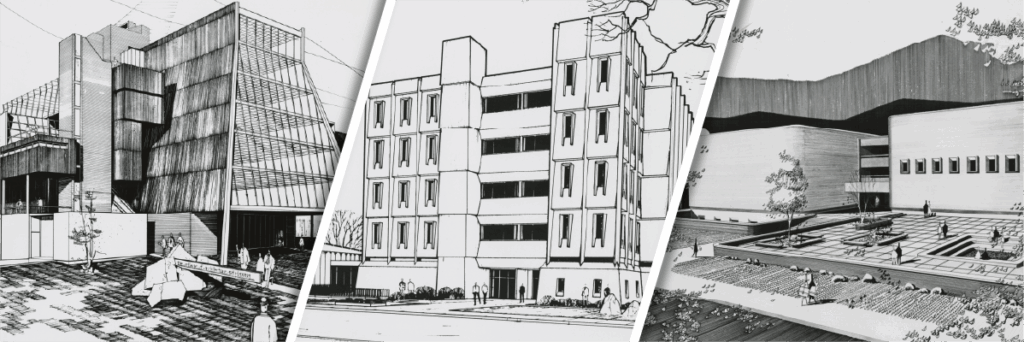October is American Archives Month, an annual celebration promoting the use of archives and the preservation of historic records across the United States. In commemoration, the Ball State University Libraries, in collaboration with the R. Wayne Estopinal College of Architecture and Planning, presents:
ReCAPping Possibility: Alternate Designs for the College of Architecture and Planning, 1967-1968
The R. Wayne Estopinal College of Architecture and Planning at Ball State University was established in 1965 by the Indiana General Assembly. First-year students were accepted the following fall in September of 1966. Establishment of the College was the result of considerable time and effort by many individuals and groups, including: the Indiana General Assembly, the four Indiana state-funded universities [at the time], the faculty and staff of Ball State University, the Indiana Society of Architects, the American Institute of Architects, the Association of Collegiate Schools of Architecture, the National Architectural Accrediting Board, and others. Several of these groups proposed that the architect for the new building be chosen by a competition open to architects registered and resident in the State of Indiana.
The two-stage competition was initiated in July of 1967. Initial competition entries were submitted and reviewed anonymously. In total, forty submissions were received representing 28% of all active architects and/or firms in the State of Indiana at the time. First-stage entries required the submission of the following drawings: site plan, floor plans, at least two sections, exterior perspective (at eye level), and two elevations.
Entries were required to accommodate a building approximately 43,000 square feet in size, including electrical, mechanical, service facilities, and circulation spaces. The estimated construction cost was not to exceed $1,300,000. Key programmatic requirements featured “special function” spaces, including: a library, auditorium, shop facilities, photography studios, exhibition and gallery space, seminar spaces, a faculty conference room, departmental offices, staff offices, and design studios. Entries should also be easily expandable to meet future needs of the College.
Five first-stage winners were announced in November of 1967. Each of the five architectural firms was awarded $2,500 [approximately $24,000 today] and asked to compete in a second three-month stage. The final winner, Melvin D. Birkey of South Bend, was announced on January 19, 1968. Groundbreaking for the building took place in late 1969.
In 2025, sixty years following the establishment of ECAP, the building is enduring one of the most expansive renovation projects in decades. This exhibit rewinds the clock to the 1960s, the early days of the College, and the design competition that started it all, providing a glimpse of “what could have been” through unbuilt selections from the Andrew Seager Archives of the Built Environment.
The exhibit is free and open to the public and will be on display in the first-floor corridor of the Estopinal College of Architecture and Planning through November 21, 2025.
For more information, contact the Andrew Seager Archives of the Built Environment at ASALIB@bsu.edu.

